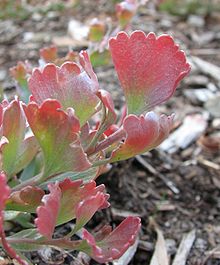
Kwongan is a plant community found in south-western Western Australia. The name is a Bibulman Aboriginal term of wide geographical use defined by Beard (1976) as
...a type of country ...[that is] sandy and is open without timber-sized trees but with a scrubby vegetation. It consists of plains in an Australian sense of open country rather than in a strict sense of flat country. ... there are two principal plant formations in the kwongan, scrub heath and broombush thicket ... both ... are sclerophyll shrublands and possess a certain unity when contrasted with woodland and forest or steppe and succulent steppe communities.
Kwongan has replaced other terms applied by European botanists such as sand-heide (Diels 1906) or sand heath (Gardner 1942), giving priority to the language of people who have lived continuously in the southwest for more than 50,000 years. Recent archeological evidence shows occupation of the Kwongan for at least 25,500 years.[1]
Thus, kwongan has come again into common usage for the Southwest Australian Floristic Region's shrubland vegetation and associated countryside, equivalent to South Africa's fynbos, California's chaparral, France's maquis and Chile's matorral as seen in these other regions of the world experiencing a Mediterranean climate.
- ^ Monks, Carly; Dortch, Joe; Jacobsen, Geraldine; Baynes, Alexander (3 November 2016). "Pleistocene occupation of Yellabidde Cave in the northern Swan Coastal Plain, southwestern Australia". Australian Archaeology. 82 (3): 275–279. doi:10.1080/03122417.2016.1244216. S2CID 152130030. Retrieved 4 June 2017.